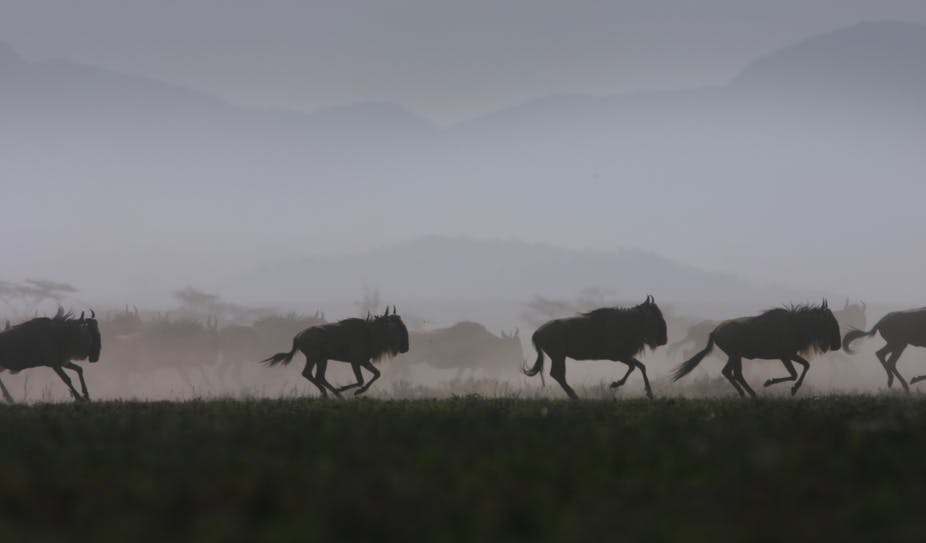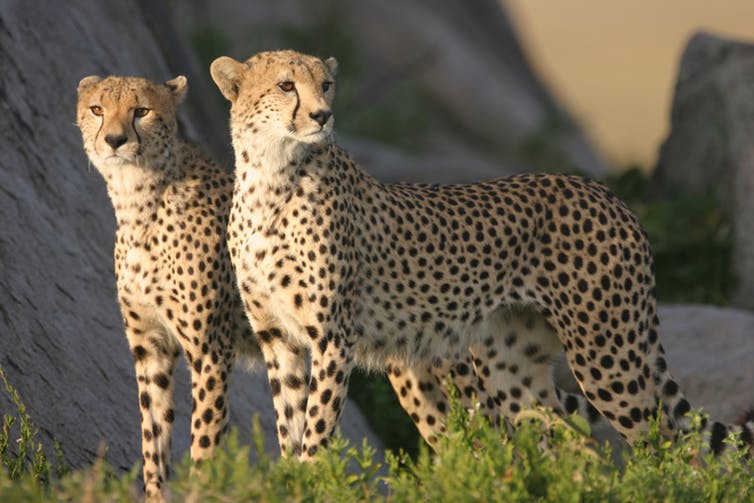Fences are an increasing threat to Africa’s migratory wildlife
Posted: Wed Apr 04, 2018 5:06 pm

In the Serengeti wildebeest will move more than 2000km during their annual migration. Sarah Durant
BY SARAH DURANT - 9 AUGUST 2017 - THE CONSERVATION
Wildebeest rarely stay still for long. With sloping hindquarters, and an easy loping gait, their bodies are designed to move. In the Serengeti ecosystem, for instance, a wildebeest will move over more than 2,000 kilometres during their annual migration.
Migratory or nomadic animals, like wildebeest, that live in drylands need to move over vast distances to find sufficient water and nutrients. They follow localised and variable rainfall and food resources.
The Serengeti wildebeest spends the wet season, November to April, on the short grass plains of the southern Serengeti National Park and adjoining Ngorongoro Conservation area in Tanzania. Here they feed on nutritious grass shoots that grow in response to the abundant rain. But even here, they do not stay still. They constantly move across the short grass plains in search of the fresh grass that grows after each new rainfall. This allows mothers to maximise milk production for their calves, born during a simultaneous calving of more than a quarter a million, peaking in February.
When the rains cease at the end of April, the wildebeest start their long journey to their dry season grazing areas. They first move west, and then head north, following the remaining water in the rivers before moving on as they dry out. Eventually they reach the only permanent water found in the Mara River on the Kenyan border. The dry season is hard, and many wildebeest die of starvation during this period.
When the rains start in November, the wildebeest lope down south once again. They make the journey to the short grasslands nearly 200km away in just a few days. Here they graze, recover their strength and the cycle begins again.
If these Serengeti wildebeest were to face a barrier at any point in their journey, they would die, either of starvation or thirst. Sadly, this has happened to migratory animals elsewhere in Africa. For example, over 30 years ago, after a fence was erected as a veterinary cordon to separate wildlife from cattle in the Kalahari, 80,000 wildebeest and 10,000 hartebeest died when they were no longer able to access permanent water during a drought. The fence was built to satisfy European Union livestock disease regulations, and allow southern African countries to export meat into the European Union.
Unfortunately, the ability of wildlife in Africa to continue to move across landscapes is still being threatened by linear barriers, and this is particularly a problem in Africa’s drylands.
African drylands
African drylands are home to most of its large mammal species. These include semi-arid and arid savannahs, found across much of eastern and southern Africa, which support spectacular wildlife migrations, such as those found in the Serengeti. But drylands also include hyperarid deserts, such as the vast Sahara, home to distinctive nomadic species such as the critically endangered Addax and dama gazelle.
Because mobility is key for large mammals in these systems, subdividing land reduces the numbers of animals areas can support. To the extent that 300km2 of land in Laikipia will support 19% fewer cattle if subdivided into 10km2 parcels.
Large carnivores, which depend on wide-ranging herbivore prey, also need to range widely, and live at even lower densities than their prey. The Saharan cheetah, for example, occurs at one of the lowest densities ever documented for a big cat, with only one individual per 4,000km2.

The recent human migration crisis and growing insecurity in many dryland areas across the Sahara-Sahel has led to calls for large-scale border fencing in Africa, some of which stretch over several hundreds of kilometres.
There are also growing calls for large scale boundary fencing of protected areas as well as infrastructure developments, such as oil pipelines and railways, that cut across wildlife movement pathways. Kenya’s new Standard Gauge Railway line is a recent example.
On top of this is the problem of boundary fences erected around smaller plots of land. In southern Kenya fences put up around private farms have meshed together to form a large-scale barrier to wildlife movement.
International action
In the face of these pressures, migratory, nomadic and wide ranging species depend on trans-boundary action for their long term survival.
The UN Convention on the Conservation of Migratory Species of Wild Animals , also known as the Bonn Convention, lays the legal foundation to safeguard species that need to move across international boundaries. It also provides for internationally coordinated conservation measures throughout their migratory range.
Africa is not alone in facing barrier threats. In central Asia, linear barriers also threaten this region’s migratory wildlife. For example, the border fence and railroad between Kazakhstan and Uzbekistan bisects the Saiga antelope migration between these countries. It has helped to put this population on the brink of extinction.
In response to barrier threats, the Convention on the Conservation of Migratory Species established the Central Asian Mammals Initiative This produced an important set of guidelines to inform fencing interventions and to help sustain migration corridors for migratory ungulates in Asia.
These guidelines are now being followed up with action. A project has been initiated to partially remove and modify the fences along the Trans-Mongolian Railway. This had formed a major barrier to movement for kulan (wild ass) and Mongolian gazelles. Furthermore, border fence modifications recommended by the Bonn Convention on the Conservation of Migratory Species are being implemented to enable Saiga to move, once again, between Kazakhstan and Uzbekistan.
African issues on the table
The Bonn Convention on the Conservation of Migratory Species has just held the Second Meeting of the Sessional Committee of its Scientific Council. This is in the run up to the Conference of the Parties in October where countries will come together to agree on new actions to save migratory species. Under discussion was a new African Carnivore Initiative, which seeks to develop a framework for the trans-boundary conservation of existing Bonn Convention listed large carnivore species, cheetah and African wild dog, and to add two as yet unlisted species, lion and leopard, to the initiative.
Also on the table was an important new initiative to maintain connectivity for terrestrial species, including an additional decision requested by the Zoological Society of London to address the problem of linear barriers in Africa, building on the experiences under the Central Asian Mammals Initiative.
If Africa to avoid catastrophic impacts of large scale fencing on its wildlife in the future, we must avoid repeating past mistakes. This will require further scientific research to better understand potential negative impacts of fencing and other linear barriers, and how best to mitigate such impacts, not just for wildlife, but also for ecosystem services and local communities.
At the Bonn Convention’s next Conference of Parties, nations will need to decide whether to implement important decisions to safeguard migratory species, including maintaining terrestrial connectivity. The fate of many wide ranging species hangs in the balance, and depends on governments supporting and, importantly, implementing, these decisions.
Read original article: https://theconversation.com/fences-are- ... life-81338